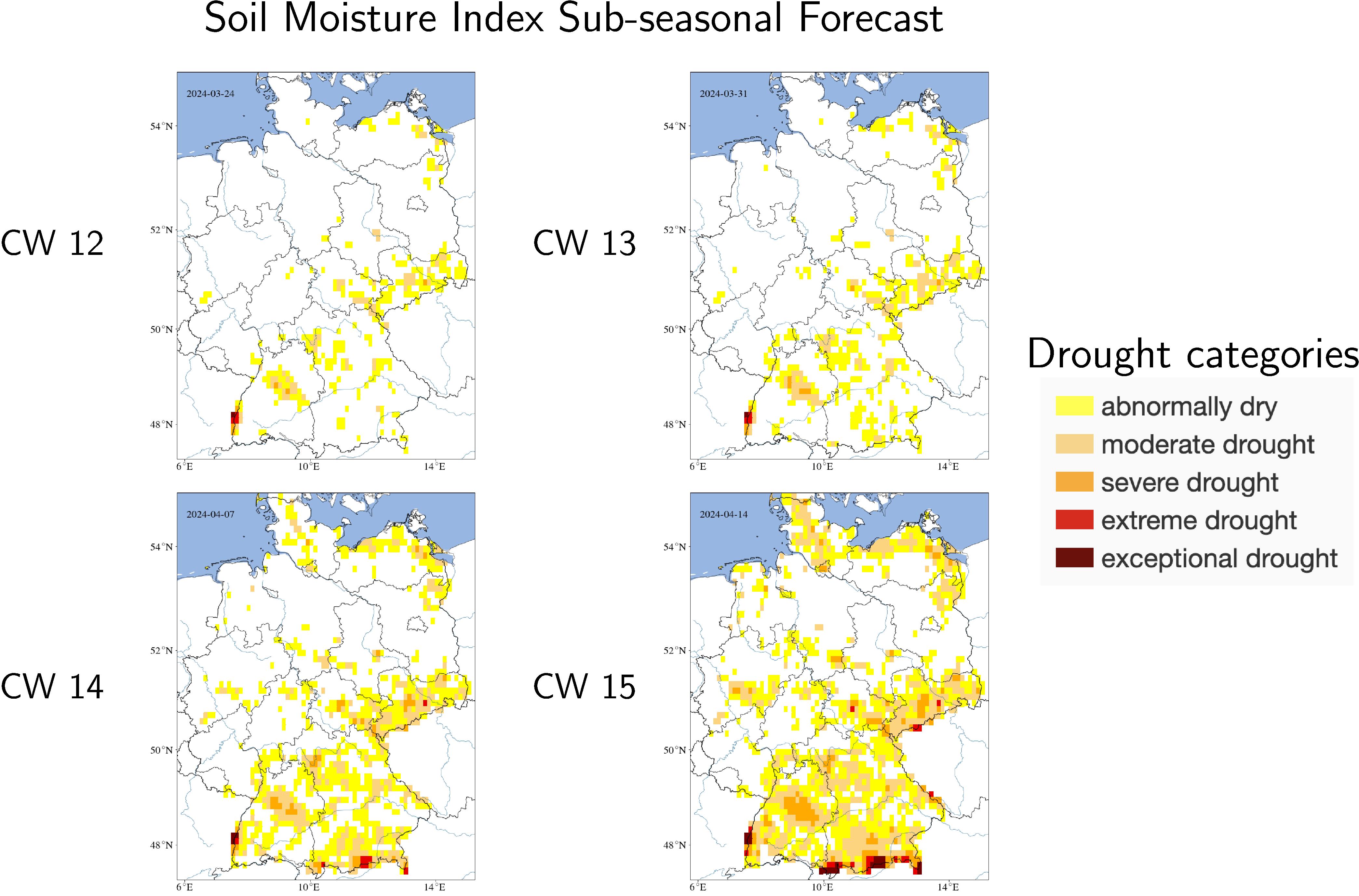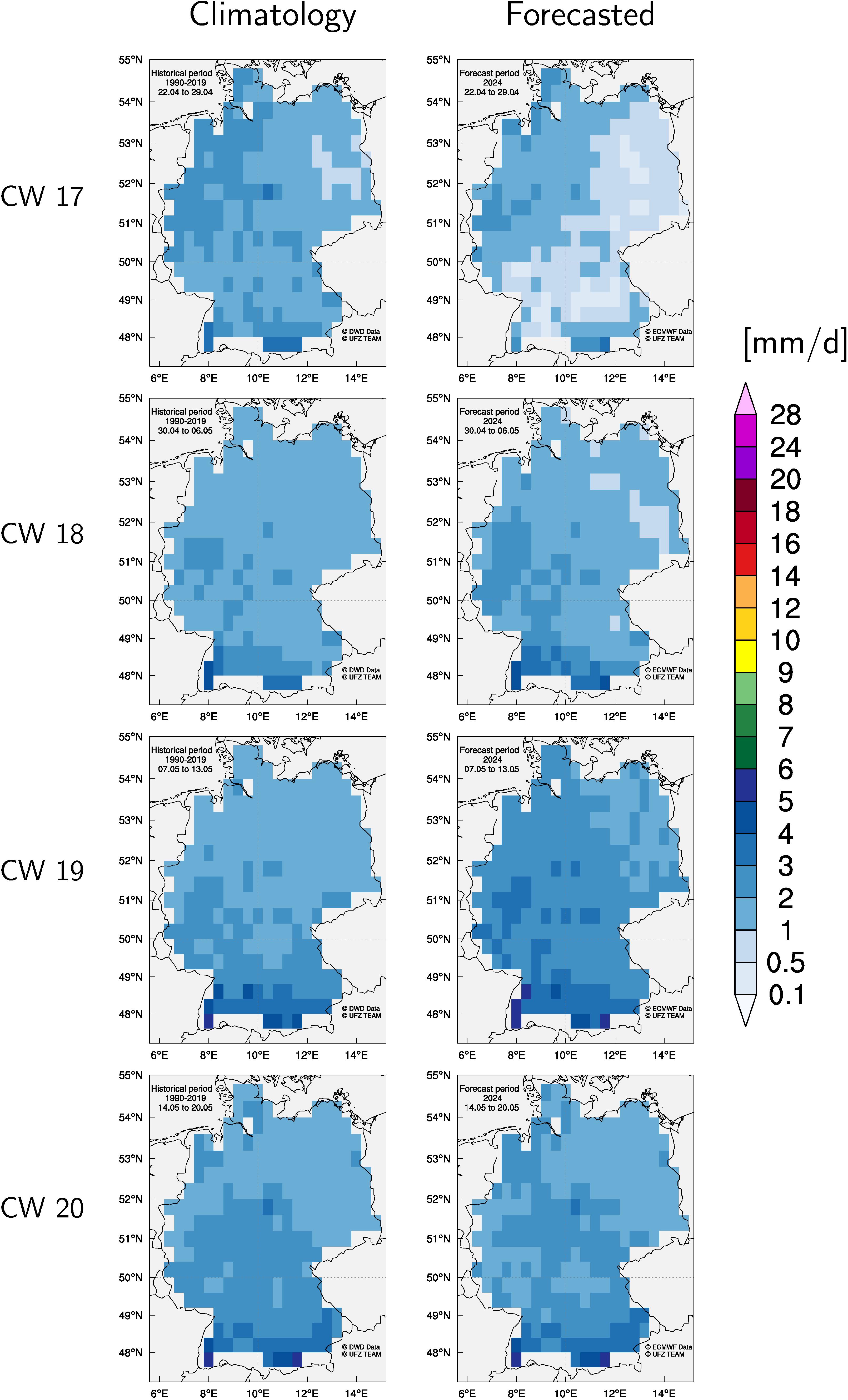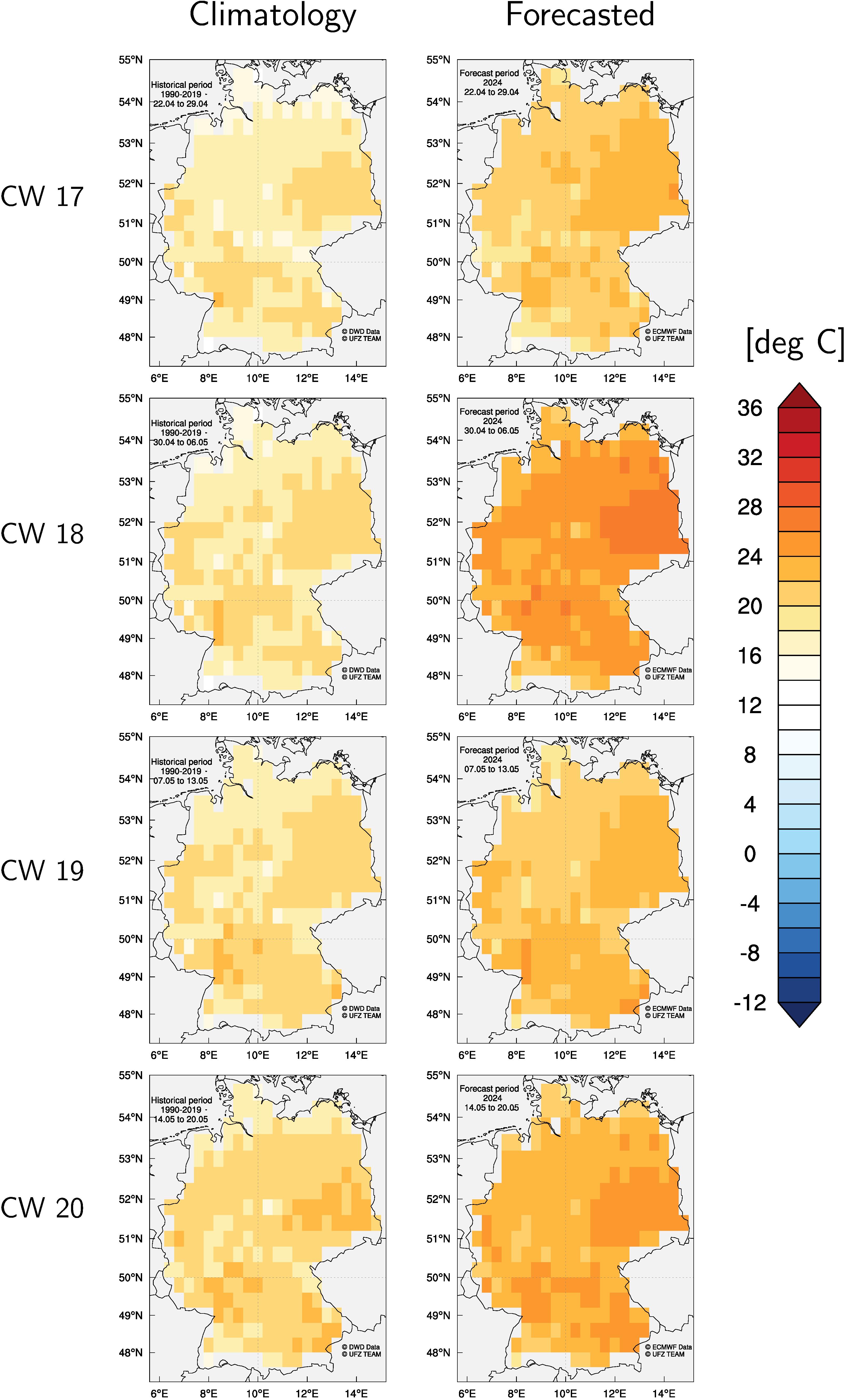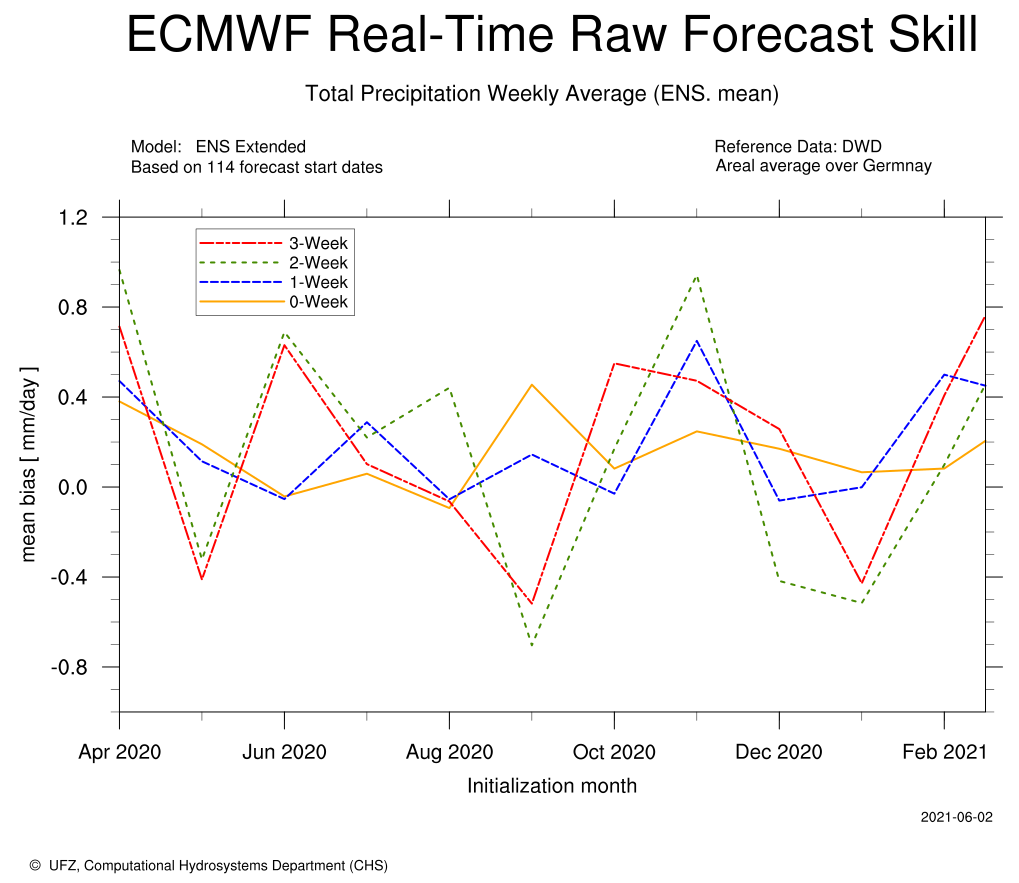Sub-seasonal Hydroclimatic Forecasting System
This page provides weekly real-time subseasonal-to-seasonal hydroclimatic (HS2S) ensemble forecasts for Germany. HS2S uses ECMWF ENS extended meteorologic forecasts on sub-seasonal time scales which are disseminated each Tuesday and Friday over entire Germany in this web portal. The climatology over Germany is based on DWD data. The hydrological forecasts are based on the mHM model. Our HS2S system aims to support MOSES researchers to plan event-driven campaigns (hydrological extremes and heat waves) and to investigate the evolution of upcoming heatwaves and drought events. The forecast information could also be used for impact assessment in agriculture and energy sectors in addition to environment considerations.
The HS2S system provides forecasts for soil moisture, streamflow, precipitation, near surface air temperature and river temperature. All forecasts will be updated automatically every week and issued for the next four calendar weeks.
Hydrological Forecasts
Soil Moisture Index (SMI)

This figure shows the forecasts of Soil Moisture Index (SMI) over Germany for the for upcoming calendar weeks at 0.125 degree spatial resolution. SMI forecasts are based on mHM real-time ensemble runs forced by the latest sub-seasonal atmospheric forecasts provided by the European Center for Medium-range Weather Forecast (ECMWF). Hydrologic initial condition for the forecast start day is derived by forcing mHM with the latest DWD station data. Similar approach to the German Drought Monitor is considered for interpolating station data to gridded using external drift kriging. ECMWF forecasts are bias corrected with respect to the re-forecast period between 2001-2020. Soil moisture is simulated over the total soil column (2 meter).
Atmospheric Forecasts and Climatology

This figure provides climatological averages of precipitation, which are the means of weekly values of cumulative precipitation of the given calendar week computed over the 1990-2019 historical period based on DWD data. For the same calendar week, cumulative precipitation forecast from ECMWF Ensemble Extended is bias corrected and shown on the right. One can then compare climatological long-term averages with precipitation forecasts the upcoming weeks. DWD station data are interpolated using the External Drift Kriging (EDK) developed by Samaniego et al. (2011).

This figure provides climatological averages of maximum air temperature, which are the means of the maximum values of the variable computed over the 1990-2019 historical period based on DWD data. For the same calendar week, maximum air temperature forecast from ECMWF Ensemble Extended product is bias corrected and shown on the right. One can then compare climatological long-term averages with forecasts of the upcoming weeks. DWD station data are interpolated using the External Drift Kriging (EDK) developed by Samaniego et al. (2011).
Methodology
Sub-seasonal to Seasonal (S2S) Forecasts
Sub-seasonal to seasonal (S2S) forecasts aims to bridge the gap between medium-range weather forecasts (up to 10 days) and seasonal climate predictions (above a month). Compared to medium-range, sub-seasonal predictions (sometimes referred as extended) are issued on a daily basis, or once/twice per week but with increased lead times up to about 45 days. A real-time S2S forecasting system could provide tailored information for early warning of high impact extreme events. For HS2S application, 6-hourly real-time and re-forecast products from European Centre for Medium-Range Weather Forecasts (ECMWF) are retrieved. For more information, see ECMWF Ensemble Extended forecasts.
Forecast Terminology
- Forecast start date: The day on which a forecast is issued (e.g. July 6, 2020, Monday).
- Forecast (target) period: Time period analyzed in a forecast. In other words, the aggregated period for which a forecast is valid. It will be provided in weekly basis based on calendar weeks in this web-page.
- Forecast lead time: The time period between the forecast start date and the beginning of the forecast target period. For example, the forecasts issued on Monday has 0-week lead-time for the same calendar week (target period).
- Initial condition uncertainty: The output of numerical weather predictions are uncertain. On source of the uncertainty is the initial conditions of the atmosphere. By accepting this uncertainty, centers issuing weather and climate forecasts produce probabilistic forecasts based on Ensemble Prediction System (ENS). Different realisations are generated by perturbation of an unperturbed (control) forecast.
Pre-processing Data
Data generated from Earth-system models usually requires pre-processing. All information need to be converted into file formats which are conventional for the description of Earth sciences data. Big data consists of many records from in-situ observation and numerical weather prediction are processed in this stage to be compatible with other software tools in modeling chain. This step includes quality control of data and temporal aggregation of the original atmospheric model outputs (6 hourly) to the target period in which the forecast is disseminated or to the resolution required for next modeling chain.
Bias Correction
The raw outputs of Numerical Weather Prediction systems have model biases raised from the many sources of systematic errors. A comparison of ECMWF real-time ensemble forecasts and DWD grided data between April 2020 to March 2021 has been done for precipitation. Mean bias ranges between -1 and 1 mm/day for all forecast lead-times. Systematic error needs to be removed from atmospheric model outputs to avoid propagation to model chain (e.g. hydrological modeling).
 This figure illustrates ECMWF ensemble extended deterministic skill (mean bias) for all real-time forecasts initialized between April 1, 2020 and March 31, 2021 (114 start day in total). All forecasts issued in each month are averaged first, then the spatial average is calculated for all grid cells located in Germany in native model resolution (0.2 degree for 0 and 1-week lead times and 0.4 degree for 2 and 3-week lead times). DWD data are interpolated based on near real-time in-situ observations using External Kriging Drift (EDK) to generate grided observation fields.
This figure illustrates ECMWF ensemble extended deterministic skill (mean bias) for all real-time forecasts initialized between April 1, 2020 and March 31, 2021 (114 start day in total). All forecasts issued in each month are averaged first, then the spatial average is calculated for all grid cells located in Germany in native model resolution (0.2 degree for 0 and 1-week lead times and 0.4 degree for 2 and 3-week lead times). DWD data are interpolated based on near real-time in-situ observations using External Kriging Drift (EDK) to generate grided observation fields.
To remove the bias from atmospheric forecast ensembles, a trend-preserving approach will be applied before hydrological simulation. It follows a modified version of the method propsed by Lange (2019) for S2S time scale. More information on the method can be found in Ulysses project.
mHM
Hydrological ensemble forecasts are generated based on mesoscale hydrologic model (mHM). Basin-wise calibrations over Germany from (HI-CAM project) is used for model set-up. To generate the initial conditions of the hydrological forecast, mHM is forced with near real-time meteorological in-situ data from 1500+ stations provided by the German Weather Service (DWD). HS2S takes advantage of Multiscale Parameter Regionalization (MPR) to provide high resolution drought predictions.
Soil Moisture Index
The method proposed in Samaniego et al. (2013) and Samaniego et al. (2018) is implemented to generate SMI forecasts for the next 4-week lead-time. It uses a kernel density estimator with a gaussian kernel for transforming soil moisture values to the soil moisture index (SMI). For more information, please visit SMI web-page. The figures provided in this web-page are currently based on ensemble mean from 51 real-time soil moisture forecast ensembles.
UFZ Developer Team and Collaborators
The HS2S is under development by joint efforts of a team consisting of postdoctoral and senior researchers at CHS department of the UFZ.
Service Manager: Husain Najafi
Contact Person and Coordinator: Luis Samaniego
Hydroclimate Forecast Team: Husain Najafi, Pallav Sherestha, Stephan Thober and Luis Samaniego
Technical Support: Friedrich Boeing, Matthias Kelbling
Outreach: Andreas Marx
MOSES Coordinator: Ute Weber
Terms of Use, Copyright Disclaimer and License Agreement
- All forecast maps disseminated by the UFZ team on this webpage are based on research experiments.
- The material on this website does not constitute legal or other professional advice.
- Copyrights are placed in the text, images, and all other contents disseminated on this webpage.
- Observation records of precipitation, and air temperature which are the database for calculating climatology or bias correction of atmospheric forecasts are averaged over individual values of freely available data by the Deutscher Wetterdienst (DWD).
- Atmospheric forecasts are used for carrying out research purposes using real-time (valid) ECMWF products. They are disseminated to the UFZ under ECMWF Standard License.
- Research outputs (forecast maps) are openly published without any delay linked to commercial development.
